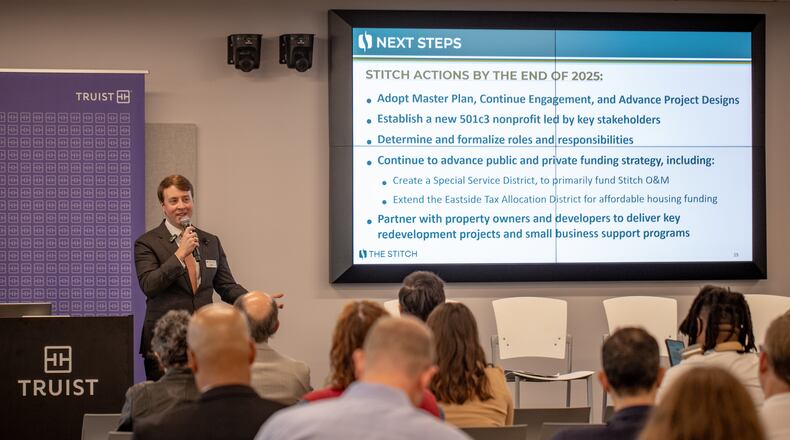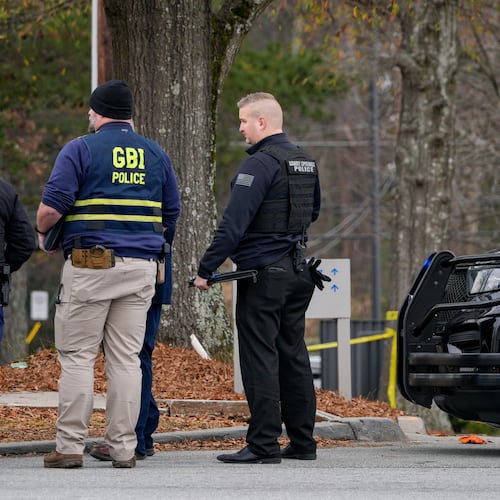The proposed Stitch master plan calls for a special tax district to help pay for the massive redevelopment project that will reconnect parts of downtown Atlanta cutoff by the interstate highways.
Officials from Central Atlanta Progress and the Atlanta Downtown Improvement District, which originated the idea for The Stich, shared an overview of the master plan Wednesday. The full plan is expected to be released to the public later this month.
“This is the road map for the transformation of all of north downtown,” said Jack Cebe, who is overseeing the project.
The first phase of The Stitch involves a 14-acre greenspace that will be built over the Downtown Connector beginning in 2026. About $200 million, mostly in federal grants, has been secured to pay for that part of the project.
The park is considered “the heart of The Stitch,” Cebe said.
“We wanted to make sure there’s a little something for everyone in this first phase to make it as impactful as possible right out of the gate,” he said.
The full project would encompass far more than the park.
The master plan proposes transportation improvements on roughly eight miles of streets, the redevelopment of properties abutting The Stitch and an increase in affordable housing.
When the park covering the interstate is complete, businesses that once backed up to the highway will have a front door to the park. Cebe said the master plan has recommendations to redesign those properties. The plan calls for retail and restaurants along the park but the final designs will be up to the individual property owners.
The master plan also includes a recommendation that 30% of new and existing housing within a half-mile of The Stitch qualify as affordable.
The Stitch phase one: Before and After
Carrying out the plans is expected to require zoning changes. Cebe said the master plan will recommend something akin to the Beltline Overlay District, which regulates development along the Beltline corridor.
“We envision a lot of these recommendations around urban design, land use and housing to be codified in zoning to help support the goals of the district moving forward,” Cebe said.
In addition to zoning changes, the master plan proposes the creation of a special service district, in which commercial and multifamily property owners would pay an additional tax, to fund The Stitch’s operations and maintenance.
Special service districts are different from tax allocation districts, a zone where governments freeze property tax collections to the value of the property pre-development and use future increases to pay for infrastructure and development.
The Beltline has both a tax allocation district and a special service district.
The Stitch master plan also calls for extending the boundaries of the existing Eastside tax allocation district to help pay for affordable housing.
Cebe said the Beltline’s governance structure served as a model for The Stitch team. The park will be city-owned but the master plan calls for the creation of a nonprofit entity similar to Atlanta Beltline Inc. to operate and maintain the park, which will require specialized maintenance because it will be located on top of an interstate.
Any zoning or tax district changes would need to be approved by the Atlanta City Council, and agreements with other partners like the Georgia Department of Transportation, MARTA and the Atlanta Regional Commission also must be finalized in the coming months, Cebe said.
“This is the next big infrastructure project for Atlanta, and it’s going to take a little bit of everybody making this thing happen,” he said.
Atlanta City Council Member Amir Farokhi, whose District 2 encompasses The Stitch, said the project has the potential to define the city.
“What happens downtown doesn’t just affect downtown,” he said. “It shapes the reputation of the region, of the state. If you do it right you create spaces where people want to be.”
Central Atlanta Progress plans to release the full 400-plus page master plan on Oct. 31 at thestitchatl.com. Public comment will be open for 60 days.
About the Author
Keep Reading
The Latest
Featured




